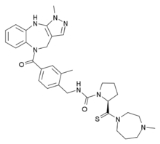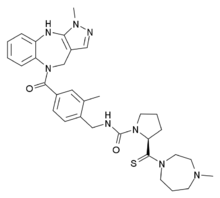
Oxytocin receptor
Encyclopedia
The oxytocin receptor, also known as OXTR, is a protein
which functions as receptor
for the hormone
and neurotransmitter
oxytocin
. In humans, the oxytocin receptor is encoded by the OXTR gene
., which has been localized to human chromosome 3p25.
family, specifically Gq, and acts as a receptor for oxytocin. Its activity is mediated by G protein
s which activate several different second messenger systems.
Oxytocin receptors are expressed by the myoepithelial cells of the mammary gland
, and in both the myometrium
and endometrium
of the uterus
at the end of pregnancy
.
The oxytocin-oxytocin receptor system plays an important role as an inducer of uterine contractions during parturition and of milk ejection.
Oxytocin receptors are also present in the central nervous system
. These receptors modulate a variety of behaviors, including stress and anxiety, social memory and recognition, sexual and aggressive behaviors, bonding (affiliation) and maternal behavior. (See the oxytocin
article for more details.)
In some mammals, oxytocin receptors are also found in the kidney
and heart
.
receptors make it difficult to achieve high selectivity.
Non-peptide
Non-peptide
Protein
Proteins are biochemical compounds consisting of one or more polypeptides typically folded into a globular or fibrous form, facilitating a biological function. A polypeptide is a single linear polymer chain of amino acids bonded together by peptide bonds between the carboxyl and amino groups of...
which functions as receptor
Receptor (biochemistry)
In biochemistry, a receptor is a molecule found on the surface of a cell, which receives specific chemical signals from neighbouring cells or the wider environment within an organism...
for the hormone
Hormone
A hormone is a chemical released by a cell or a gland in one part of the body that sends out messages that affect cells in other parts of the organism. Only a small amount of hormone is required to alter cell metabolism. In essence, it is a chemical messenger that transports a signal from one...
and neurotransmitter
Neurotransmitter
Neurotransmitters are endogenous chemicals that transmit signals from a neuron to a target cell across a synapse. Neurotransmitters are packaged into synaptic vesicles clustered beneath the membrane on the presynaptic side of a synapse, and are released into the synaptic cleft, where they bind to...
oxytocin
Oxytocin
Oxytocin is a mammalian hormone that acts primarily as a neuromodulator in the brain.Oxytocin is best known for its roles in sexual reproduction, in particular during and after childbirth...
. In humans, the oxytocin receptor is encoded by the OXTR gene
Gene
A gene is a molecular unit of heredity of a living organism. It is a name given to some stretches of DNA and RNA that code for a type of protein or for an RNA chain that has a function in the organism. Living beings depend on genes, as they specify all proteins and functional RNA chains...
., which has been localized to human chromosome 3p25.
Function and location
The OXTR protein belongs to the G-protein coupled receptorG protein-coupled receptor
G protein-coupled receptors , also known as seven-transmembrane domain receptors, 7TM receptors, heptahelical receptors, serpentine receptor, and G protein-linked receptors , comprise a large protein family of transmembrane receptors that sense molecules outside the cell and activate inside signal...
family, specifically Gq, and acts as a receptor for oxytocin. Its activity is mediated by G protein
G protein
G proteins are a family of proteins involved in transmitting chemical signals outside the cell, and causing changes inside the cell. They communicate signals from many hormones, neurotransmitters, and other signaling factors. G protein-coupled receptors are transmembrane receptors...
s which activate several different second messenger systems.
Oxytocin receptors are expressed by the myoepithelial cells of the mammary gland
Mammary gland
A mammary gland is an organ in mammals that produces milk to feed young offspring. Mammals get their name from the word "mammary". In ruminants such as cows, goats, and deer, the mammary glands are contained in their udders...
, and in both the myometrium
Myometrium
The myometrium is the middle layer of the uterine wall, consisting mainly of uterine smooth muscle cells , but also of supporting stromal and vascular tissue...
and endometrium
Endometrium
-Function:The endometrium is the innermost glandular layer and functions as a lining for the uterus, preventing adhesions between the opposed walls of the myometrium, thereby maintaining the patency of the uterine cavity. During the menstrual cycle or estrous cycle, the endometrium grows to a...
of the uterus
Uterus
The uterus or womb is a major female hormone-responsive reproductive sex organ of most mammals including humans. One end, the cervix, opens into the vagina, while the other is connected to one or both fallopian tubes, depending on the species...
at the end of pregnancy
Pregnancy
Pregnancy refers to the fertilization and development of one or more offspring, known as a fetus or embryo, in a woman's uterus. In a pregnancy, there can be multiple gestations, as in the case of twins or triplets...
.
The oxytocin-oxytocin receptor system plays an important role as an inducer of uterine contractions during parturition and of milk ejection.
Oxytocin receptors are also present in the central nervous system
Central nervous system
The central nervous system is the part of the nervous system that integrates the information that it receives from, and coordinates the activity of, all parts of the bodies of bilaterian animals—that is, all multicellular animals except sponges and radially symmetric animals such as jellyfish...
. These receptors modulate a variety of behaviors, including stress and anxiety, social memory and recognition, sexual and aggressive behaviors, bonding (affiliation) and maternal behavior. (See the oxytocin
Oxytocin
Oxytocin is a mammalian hormone that acts primarily as a neuromodulator in the brain.Oxytocin is best known for its roles in sexual reproduction, in particular during and after childbirth...
article for more details.)
In some mammals, oxytocin receptors are also found in the kidney
Kidney
The kidneys, organs with several functions, serve essential regulatory roles in most animals, including vertebrates and some invertebrates. They are essential in the urinary system and also serve homeostatic functions such as the regulation of electrolytes, maintenance of acid–base balance, and...
and heart
Heart
The heart is a myogenic muscular organ found in all animals with a circulatory system , that is responsible for pumping blood throughout the blood vessels by repeated, rhythmic contractions...
.
Ligands
Several selective ligands for the oxytocin receptor have recently been developed, but close similarity between the oxytocin and related vasopressinVasopressin
Arginine vasopressin , also known as vasopressin, argipressin or antidiuretic hormone , is a neurohypophysial hormone found in most mammals, including humans. Vasopressin is a peptide hormone that controls the reabsorption of molecules in the tubules of the kidneys by affecting the tissue's...
receptors make it difficult to achieve high selectivity.
Agonists
Peptide- OxytocinOxytocinOxytocin is a mammalian hormone that acts primarily as a neuromodulator in the brain.Oxytocin is best known for its roles in sexual reproduction, in particular during and after childbirth...
- DemoxytocinDemoxytocinDemoxytocin or deaminooxytocin, is an obstetric drug often used in the prevention of puerperal mastitis. It is an analogue of oxytocin.- References :...
- CarbetocinCarbetocinCarbetocin is an obstetric drug used to control postpartum hemorrhage, bleeding after giving birth. It is an analogue of oxytocin, and its action is similar to that of oxytocin, such as contraction of the uterus....
Non-peptide
- Compound 39 (Ki = 33 nM, 25x selective over vasopressin receptorVasopressin receptorA vasopressin receptor is a cell surface receptor which binds vasopressin. The three types of vasopressin receptor are members of the A6 subfamily of G-protein coupled receptors.-Subtypes:Humans express three subtypes: 1A, 1B and 2-Function:...
s)
- WAY-267,464WAY-267,464WAY-267,464 is a drug which acts as a high affinity, potent, selective, and non-peptide agonist for the oxytocin receptor, with negligible affinity for the vasopressin receptors...
– anxiolyticAnxiolyticAn anxiolytic is a drug used for the treatment of anxiety, and its related psychological and physical symptoms...
in mice
Antagonists
Peptide- AtosibanAtosibanAtosiban is an inhibitor of the hormones oxytocin and vasopressin. It is used as an intravenous medication as a labour repressant to halt premature labor. Although initial studies suggested it could be used as a nasal spray and hence would not require hospital admission, it is not used in that form...
Non-peptide
- EpelsibanEpelsibanEpelsiban is a drug which acts as an non-peptide oxytocin receptor antagonist, and is being developed by GlaxoSmithKline for the treatment of premature ejaculation in men....
- GSK-221,149
- L-368,899L-368,899L-368,899 is a drug used in scientific research which acts as a selective antagonist of the oxytocin receptor, with good selectivity over the related vasopressin receptors. Unlike related drugs such as the peripherally selective L-371,257, the oral bioavailabity is high and the brain penetration of...
(CAS# 148927-60-0) - L-371,257L-371,257L-371,257 is a compound used in scientific research which acts as a selective antagonist of the oxytocin receptor with over 800x selectivity over the related vasopressin receptors...
(CAS# 162042-44-6) – peripherally selective (i.e. poor blood brain barrier penetration, few central effects) - L-372,662
- SSR-126,768
- WAY-162,720 – centrally active following peripheral administration

